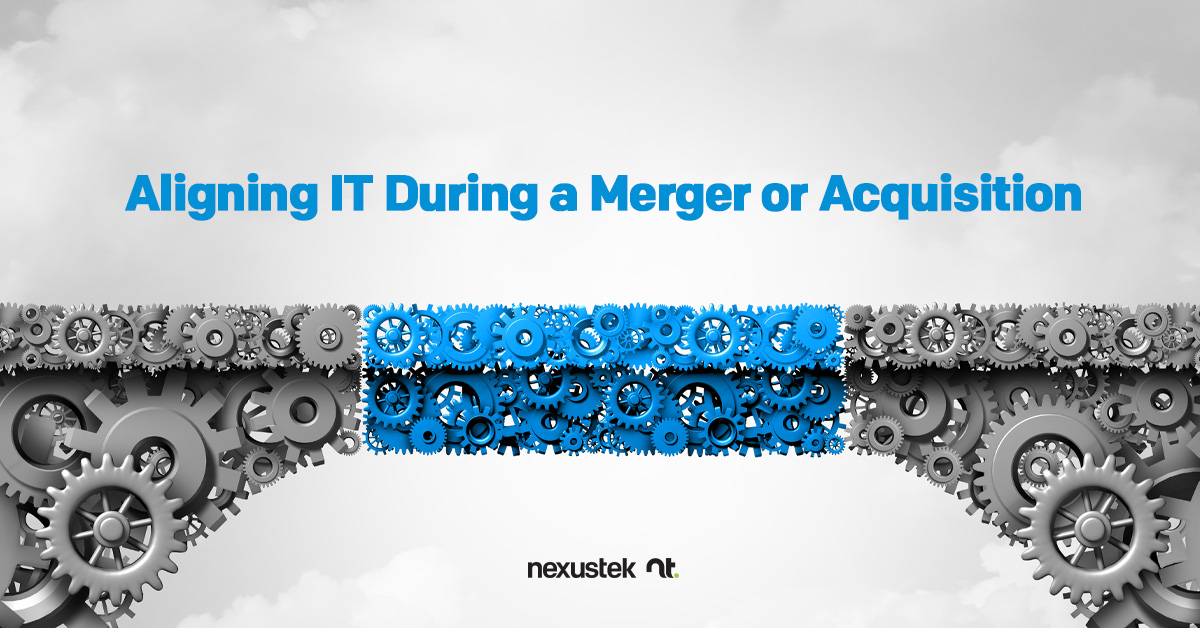READ TIME: 4 MIN

Aligning IT During a Merger or Acquisition
Mergers and acquisitions (M&As) are as promising and exciting as they are intimidating. For many small and medium-sized businesses (SMBs), merging with another organization offers the opportunity to expand beyond their immediate geographic markets and possibly diversify the products and services they offer to command a larger market share.
These attractive prospects come with some tantalizing financial possibilities: Expanding your business’ reach and taking advantage of new efficiencies brings the promise of increased revenues and reduced expenses. Over-eagerness to capture these benefits, however, can result in costly miscalculations, and in truth, only 47% of M&As result in positive returns in the first year1.
A major stumbling block for many SMBs is not taking the time to create and follow a post-merger integration (PMI) plan, a key component of which is IT integration. In fact, only 40% of businesses formally develop a PMI plan2, and many fail to appreciate the importance of strategic IT integration planning.
To give your business the best chance of success with your M&A, it is wise to construct a thorough IT integration plan, keeping the following in mind:
The due diligence stage of M&A planning must include IT.
A company’s IT infrastructure is integral to its strategic performance. Importantly, in 50-60% of M&As, the new synergies and efficiencies firms seek to gain are at least partially related to IT3. Taking the time to fully understand both organizations’ IT realities helps with accurate valuation as well as thorough integration planning, so that you’re ready to hit the ground running immediately after the deal is done.
Map out the full IT infrastructure of both organizations.
This can be a time-consuming and tedious step, but one that deserves thorough attention. In this step, you need to do a full accounting of each company’s infrastructure, including every piece of hardware, every application in use, and all subscriptions and licenses. Some important questions you need to be answering with this information include:
- How do applications and other infrastructure elements relate to operations, especially those operations that are closely associated with competitive advantage?
- What applications and data are mission-critical?
- Do you foresee functionality gaps, i.e., functions the new organization will require that are not supported by current infrastructure?
- What communication systems are in use?
- Is there outdated hardware that needs updating?
Get a thorough understanding of the IT talent across both organizations.
This includes not just titles but organizational roles, IT operational practices, and IT budget and other resources. It is also useful to learn:
- What skills and experience are possessed by IT employees across both organizations?
- Are there any skills gaps to address as you move forward with the deal?
- How do the organizations handle proactive and reactive IT issues, and are processes compatible?
Determine the desired future IT systems for the post-merger organization.
This is where you’ll need to make some tough decisions, as there will inevitably be elements of one or both organizations’ infrastructure that will need to change. Here are some considerations to guide those choices:
- “Best of both worlds” approach: Changes to tech always evoke a certain level of resistance in employees, but a great way of minimizing such resistance is by crafting a new infrastructure using a “best of both worlds” approach. This is where you incorporate the most effective tech from each organization to best meet the business goals of the post-merger organization.
- Be careful with legacy systems: Don’t rush to eliminate legacy systems just because they’re old. Legacy systems are often still around in a business because they are mission-critical, and premature discontinuation of such systems can seriously hamper operations.
- Consolidate when possible: Vendor consolidation is an important step, as it allows the new organization to take advantage of volume discounts due to its larger size. For example, software subscriptions may be less expensive when purchased at higher volumes; just make sure that you verify transferability of software and other licenses during the due diligence phase.
- Identify redundancies and streamline: This is also an ideal time to look for functional redundancies across applications, and to streamline across the newly formed organization to reduce IT costs. Keep in mind that in the average company, over 30% of software spend is wasted4; the creation of a new, post-merger infrastructure is the perfect opportunity to weed out such overspend.
- Reassess cybersecurity and cyber resilience: Finally, don’t forget to rethink your cybersecurity, as your new infrastructure will likely have new security needs. Combining elements of two previously separate IT systems may leave holes in your security posture that will need to be filled. With your new infrastructure, there will also be a need to reassess business continuity and disaster recovery, to make sure you are prepared to withstand crisis events like ransomware attacks and natural disasters.
A thoroughly planned IT integration plan can make the difference between a chaotic post-merger environment and a smoothly functioning one that is ready to capitalize on the synergies that make M&As worth the work.
Offering in-depth IT assessments and executive-level technology leadership services, NexusTek puts the expertise you need for a successful M&A at your fingertips.
References:
1, 2. Kengelbach, J., Berberich, U., & Keienburg, G. (2015, October 14). Why deals fail. BCG. https://www.bcg.com/en-ca/publications/2015/why-deals-fail
3. McKinsey & Company. (2011). Understanding the strategic value of IT in M&A. https://www.mckinsey.com/capabilities/strategy-and-corporate-finance/our-insights/understanding-the-strategic-value-of-it-in-m-and-38a#0
4. Flexera. (2022). State of ITAM report. https://info.flexera.com/ITAM-REPORT-State-of-IT-Asset-Management